
Why sprout? Using sprouted wheat berries to make bread is becoming popular due to their nutritional value. The protein and lipid content in wheat are increased with sprouting.1 Amylopectin, which can affect blood sugar levels, is decreased. Furthermore, wheat sprouts contain materials like sulforaphane and certain antioxidants that could help prevent cancer.2
Procedure for sprouted wheat berries
Step 1: Soak the wheat: add water to wheat to soak it 12-24 hours. After full hydration, the water content in the soaked wheat is around 40%. The optimal temperature for wheat soaking is 15-31oC (59-89oF). No special equipment is needed. Any suitable kitchen container can be used.
Step 2: Drain the water.
Step 3: Rinse the wheat daily.
Step 4: Choose the right sprouting time (24-38 hours) for your baking needs.
Step 5: Use a high-speed food processor (or an industrial grinder for larger outputs) to grind down the sprouted grains. Use the resulting mash to make your sprouted wheat products.
Here are the different stages of sprouted wheat:

Stage 1: Wheat soaking

Stage 2: Wheat after 24 hours of soaking

Stage 3: Wheat after 24 hours of soaking and 24 hours of sprouting (drained sprouts, not sitting in water)

Stage 4: Sprouted wheat berries after 3 days of sprouting

Stage 5: Mashed-up grains
References
- Ranhotra, G.S., Loewe, R.J., Lehmann, T.A. Breadmaking quality and nutritive value of sprouted wheat. Journal of Food Science 42.5 (1977):1373-5.
- Ronaghy, H.A. The role of zinc in human nutrition. Nutrition in the Gulf Countries. Malnutrition and Minerals World Review of Nutrition and Dietetics (n.d.): 237-54.

